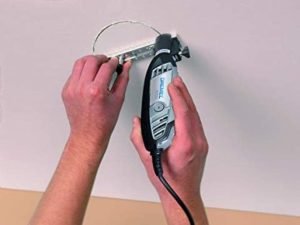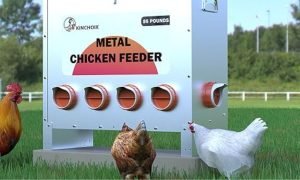Last Updated on May 6, 2024 by teamobn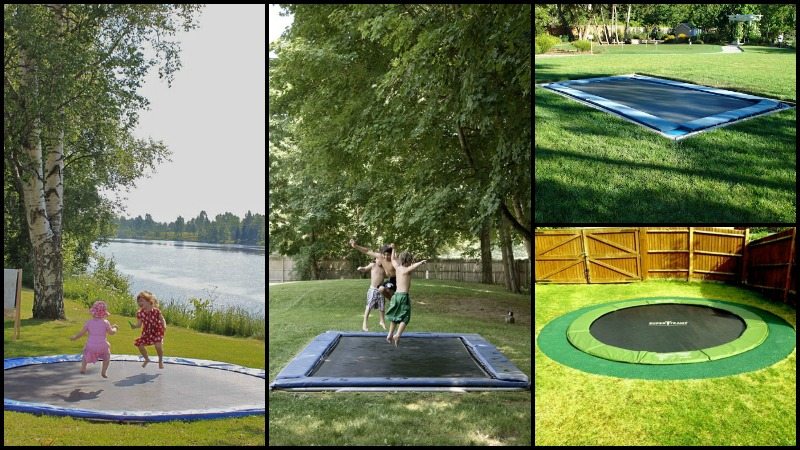
A trampoline is an excellent addition to your backyard. Kids love them and they’re a great way to have fun and burn some energy. Trampolining, also called rebound tumbling, is an acrobatic activity conducted after rebounding from the thick mesh fabric into the air.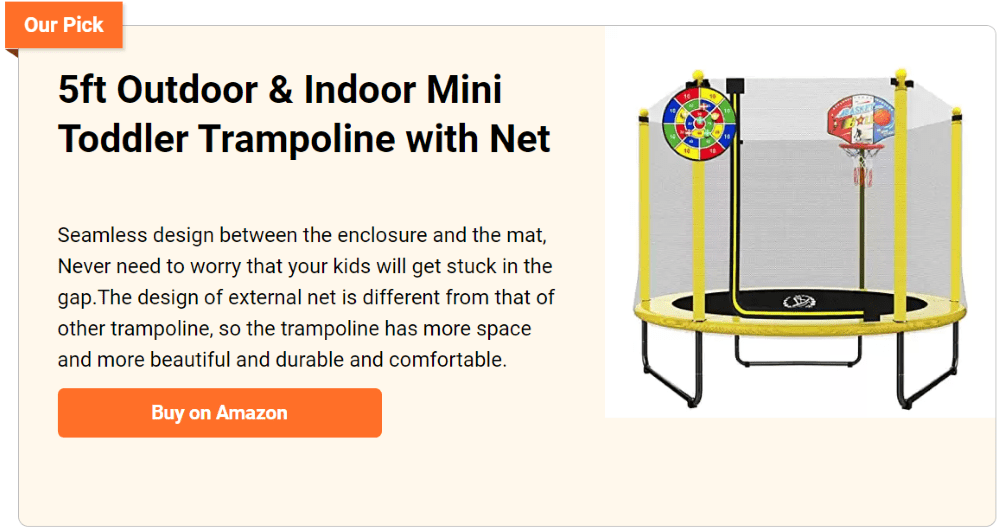
What is a Trampoline?
Trampolines are often used for kids’ games, adult fitness workouts, recreational activities, and gymnastics. Its structure is a stretched fabric wrapped around a steel frame, made of mesh.
The frame used is usually galvanized steel, durable, stable, and rest free than aluminium frames. In order for you to bounce around the top of the thick mesh fabric, the thick mesh fabrics are tightly attached to the competitive springs or recreational steel springs.
What are the advantages and disadvantages of a Trampoline?
It provides a vigorous aerobic workout, getting your heart to increase the rate at which it pumps blood around your body. The exercise involved also strengthens the muscles needed for a healthy cardiovascular system.
Rebound tumbling is an excellent way to build muscle power and burn calories. It is a fun way to strengthen the mind and body. This exercise that is used for aerobic fitness will improve your leg strength and enhance your balance and coordination, similar to dancing, surfing, and other sports activities.
In fact, According to a NASA study, jumping on these for 10 minutes is equivalent to a 30-minute run.
One of the reasons rebound tumbling workouts are so good for your core muscles is that when you jump, your upper body weight stretches the lower-back muscles and abdominal wall through gravity. In addition to your core muscles, you have those that stabilize your pelvis and other vital organs in your abdomen. Strengthening these muscles will prevent back injuries, improve posture, and prevent back pain.
Unfortunately, this rebound tumbling device also causes a lot of accidents. A disadvantage of this rebound tumbling device is that it occupies such a small area, thus posing safety hazards, in this case, trampoline injuries are more likely to occur. Always be careful and be aware of these safety measures.
This project will show you a great solution that’s safe, easy to do, and inexpensive.
What is an Inground Trampoline?
Turn your conventional trampoline into an in-ground playground! This reduces the risk of accidents as it is at the ground level. It reduces the height of the fall while the kids are jumping, and it makes it easier to step in and out.
Another advantage is that in-ground trampolines blend seamlessly into any backyard environment. Conventional trampolines can become an eyesore because of their size and height, taking your backyard’s view.
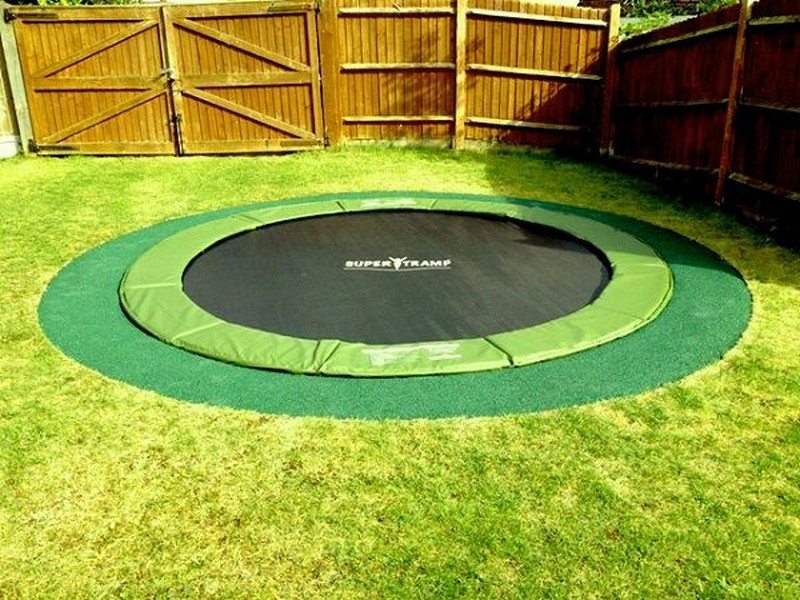
Building an Inground Trampoline
Want this in your garden without it being too conspicuous? Then turn it into an in-ground trampoline!
Materials
- 8 pieces 2X4X12 Pressure Treated Wood
- 4 sheets 4X12 Roofing Sheet Metal
- Self-Tapping Screws
- 16 pieces of Cinder Blocks (with u shape groove)
Tools
- Shovel
- Level
- Hammer
- Tin Snips
- Mitre Saw
- Drill
- Tamper – to help compact your dirt
Instructions
Step 1: Design and Planning
- Measure the size of the trampoline you intend to install.
- Mark out the area in your backyard where the trampoline will be placed. Ensure the area is level and free from overhead obstacles like branches.
Step 2: Excavation
- Using the shovel, dig a pit about 3 feet deep or to the depth that matches the height of your trampoline. The diameter should be slightly larger than the trampoline.
- Use the level to ensure the bottom of the pit is flat and even.
Step 3: Preparing the Frame
- Cut the pressure-treated wood to the needed lengths using the mitre saw. These will form the frame around the top edge of the pit.
- Assemble the frame using the drill and self-tapping screws to secure the wood pieces together.
Step 4: Setting Up the Base
- Place the cinder blocks around the inside perimeter of the pit. The U-shaped grooves should face upwards to hold the edges of the trampoline.
- Ensure the blocks are level and stable. Use the tamper to compact the soil around them for additional stability.
Step 5: Installing Drainage
- Cut the roofing sheet metal using tin snips to fit the bottom of the pit. This will serve as a barrier to prevent grass and weeds from growing upwards and also aid in drainage.
- Secure the metal sheets to the frame using self-tapping screws.
Step 6: Placing the Trampoline
- Carefully place the trampoline frame within the cinder block grooves. Ensure it fits snugly and is level.
- Attach the trampoline mesh to the frame if it’s not already pre-attached.
Step 7: Adding Safety Features
- Install any additional safety features such as safety nets around the trampoline. Attach these to the wooden frame and ensure they are tight and secure.
- Fill around the outside of the pit with soil or soft landscaping material to ease access and prevent tripping hazards.
Step 8: Final Inspection and Testing
- Check all connections and installations for stability and security.
- Test the trampoline with gradual weight increases to ensure everything is secure and functioning as expected.
One word of warning… if your soil doesn’t drain easily, make sure you put a good layer of gravel in your pit or you will be breeding hoards of mosquitoes. The gravel keeps the mozzies from reaching the water.
Click on any image to start the lightbox display. Use your Esc key to close the lightbox. You can also view the images as a slideshow if you prefer 😎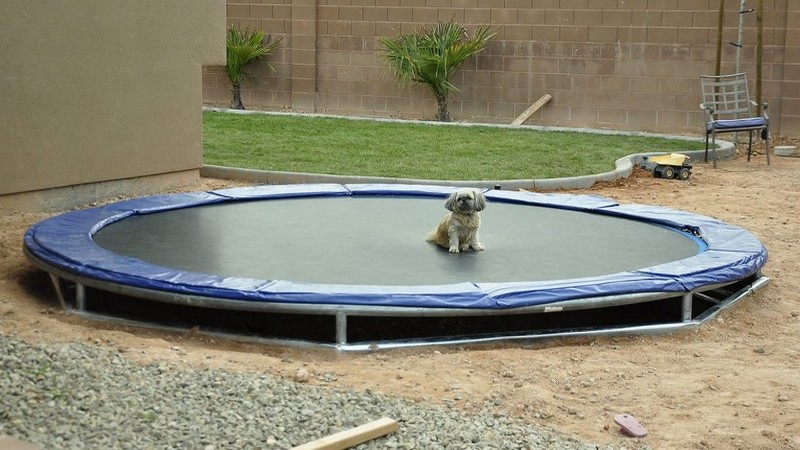
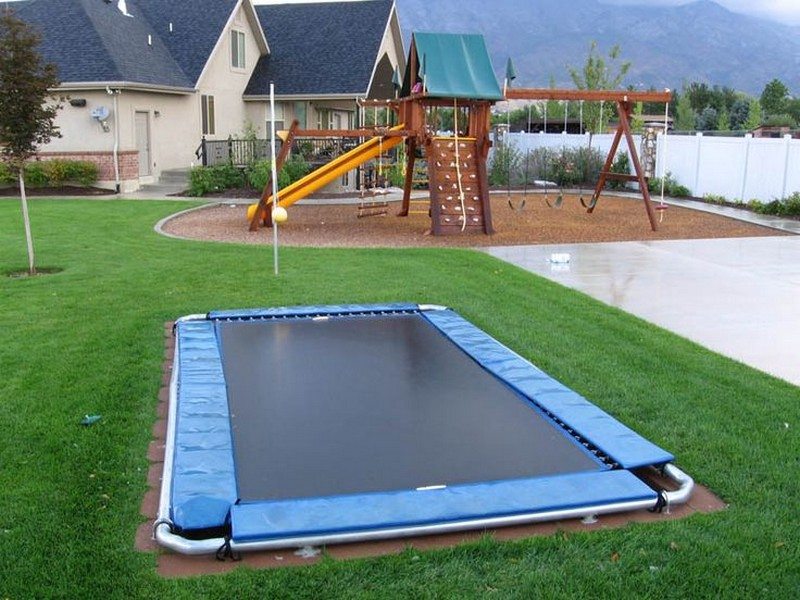
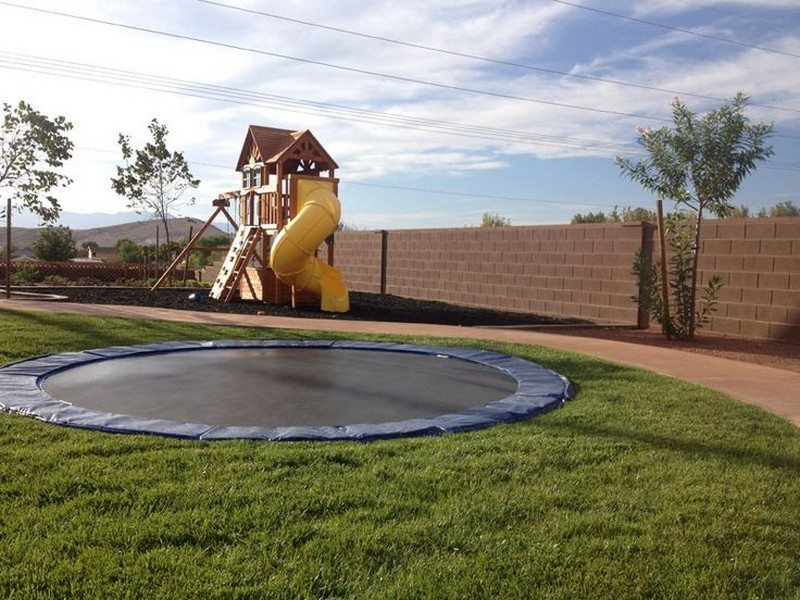

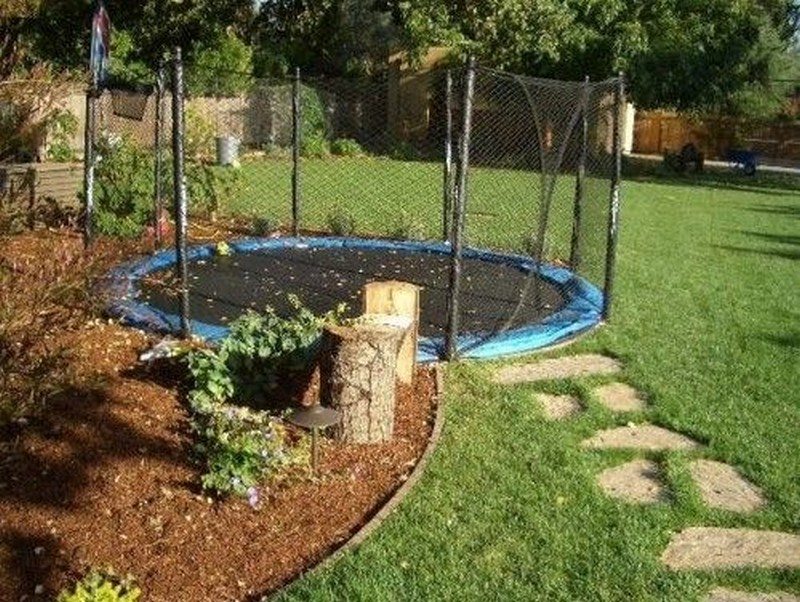
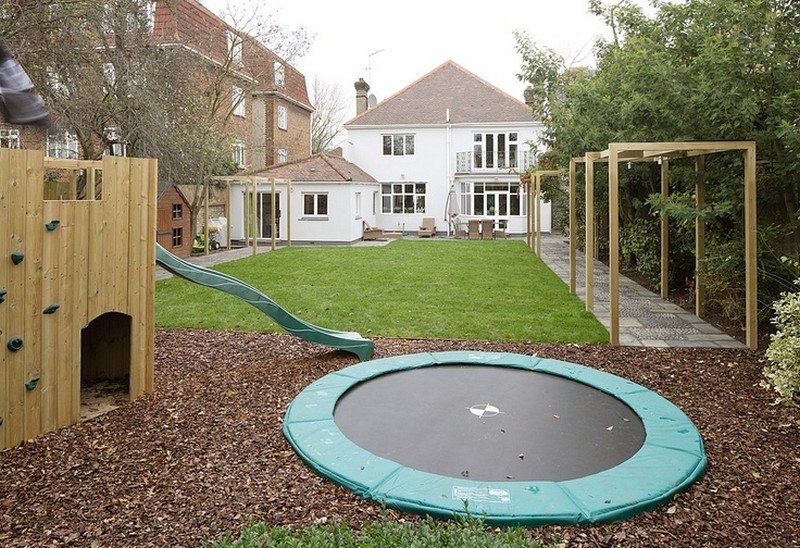
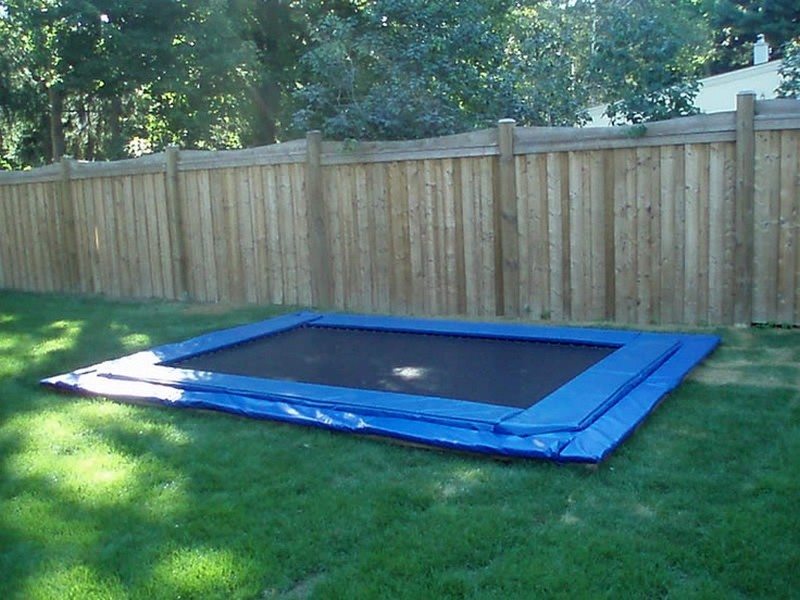
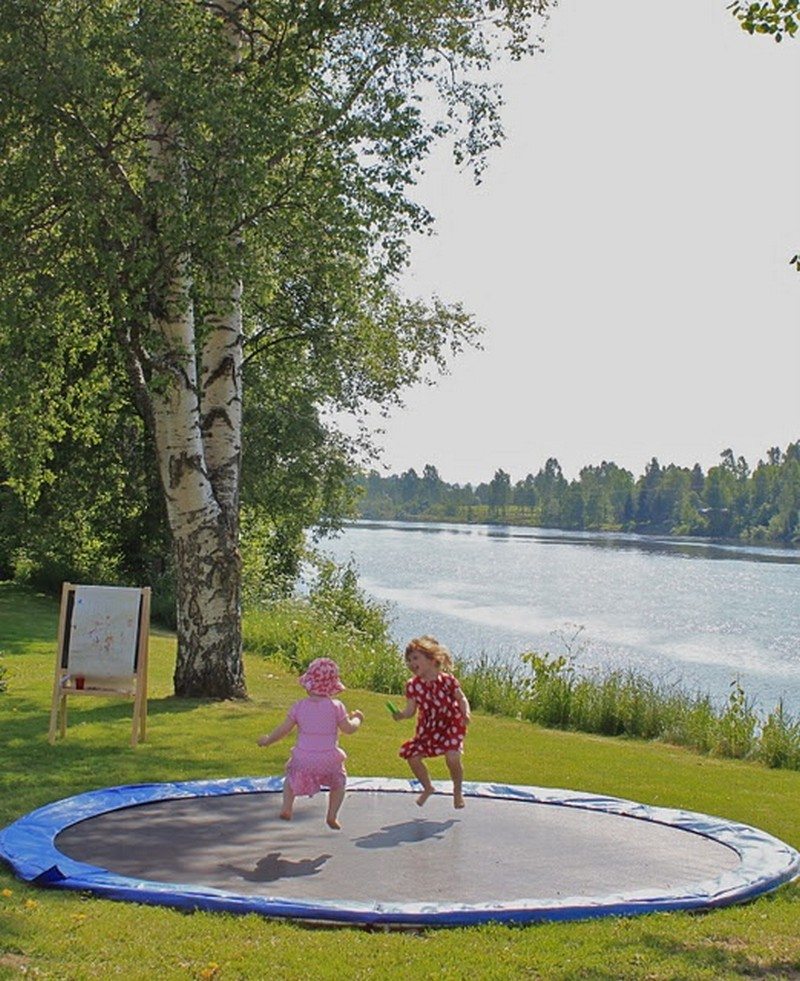
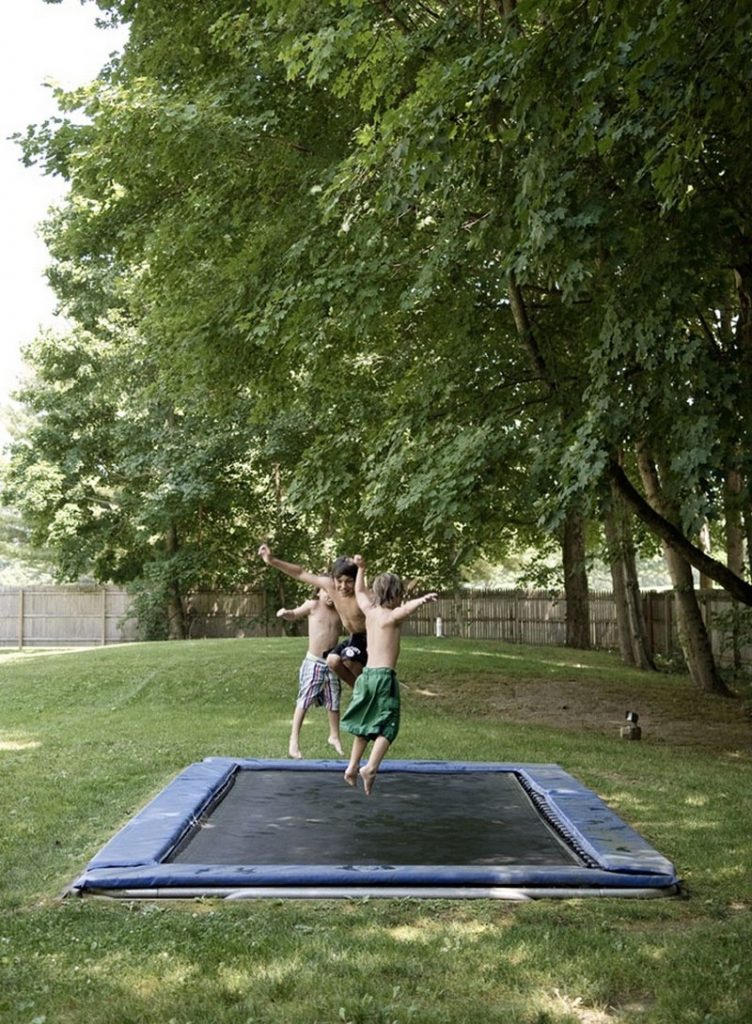

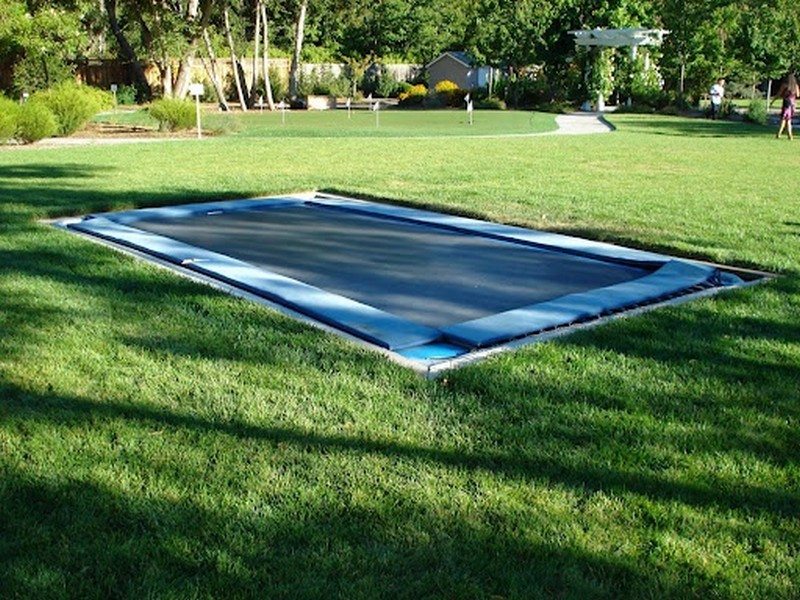
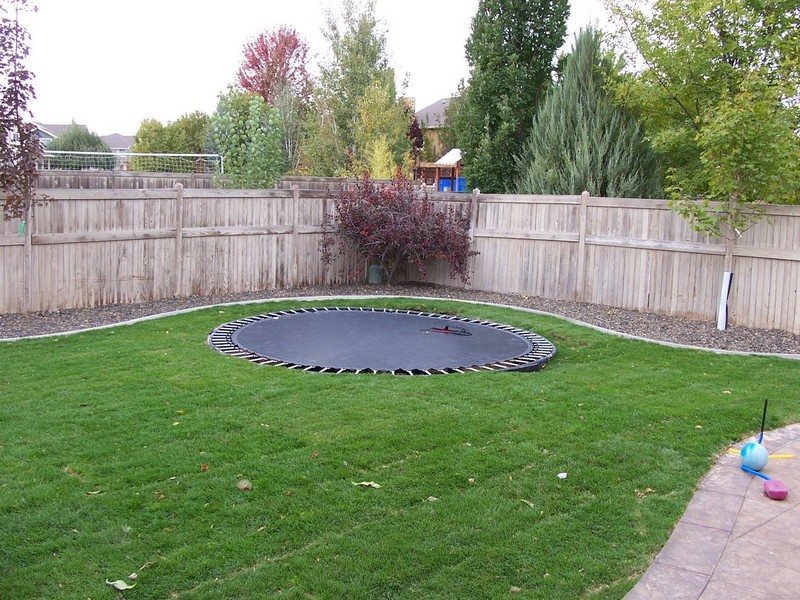
Thanks to All Things Thrifty for this great project. You can get step by step instructions here…
If you liked this project, you will also like viewing DIY projects for kids…
Here’s a quick video…
Safety Features and Enhancements
Inground trampolines offer several safety advantages over their above-ground counterparts due to their lower profile and reduced fall height. However, like all recreational equipment, they require proper safety measures to minimize risks. Implementing additional safety features can make the trampoline a safer environment for everyone, especially children.
Safety Net Installation
Installing a safety net around your inground trampoline is one of the most effective safety enhancements. Safety nets prevent users from bouncing off the trampoline and injuring themselves on the surrounding ground or garden features. Ensure the net is high enough to contain jumpers, even during high bounces, and check it regularly for any wear or tears.
Shock-absorbing Padding
Surround the edges of the inground trampoline with thick, shock-absorbing padding. This padding should cover the springs and the frame to protect jumpers from injury if they fall against them. Choose weather-resistant materials to prevent degradation and ensure the padding remains effective and safe throughout its use.
Proper Inground Installation
Ensure your inground trampoline is properly installed to maintain safety. The trampoline should be level with the ground to prevent tripping hazards. Additionally, ensure that the surrounding pit walls are secure and that there’s adequate drainage to prevent water accumulation, which can damage the trampoline and pose safety risks.
Enhanced Visibility
Mark the perimeter of the inground trampoline clearly to enhance visibility. This can be done using brightly colored materials or by installing lighting around the trampoline for evening use. Increased visibility helps prevent accidents, especially in low-light conditions.
Regular Maintenance Checks
Regular maintenance is crucial for keeping your inground trampoline safe. Inspect the trampoline regularly for any signs of wear, especially in the springs and jumping mat. Check for rust, loose screws, and degraded materials. Promptly address any issues to maintain the trampoline’s safety and integrity.
Anti-Slip Surfaces
To further enhance safety, consider applying anti-slip materials around the inground trampoline. This is particularly important in areas where users may step onto or off the trampoline. Anti-slip surfaces can prevent falls and injuries, providing a safer environment for everyone.
By integrating these safety features and enhancements, you can ensure that your inground trampoline provides not only great fun but also a safe activity for all users. Regular checks and maintenance will keep it in excellent condition, providing peace of mind and protection for your loved ones.
Maintenance and Care
An inground trampoline is a significant investment in outdoor fun and fitness. To maximize this investment, regular maintenance is crucial. Proper care keeps the trampoline safe and enjoyable for years to come. Here’s how you can maintain your inground trampoline effectively.
Regular Cleaning
- Keep It Clean: Regularly remove leaves, debris, and dirt from the trampoline mat and surrounding area. Use a soft brush or cloth to clean the mat and avoid using harsh chemicals or pressure washers, which can damage the material.
Inspect and Replace Components
- Spring Care: Check the springs regularly to ensure they are intact, rust-free, and securely attached at both ends. Replace any stretched, damaged, or rusty springs immediately.
- Mat and Net Checks: Inspect the jumping mat and safety net for any signs of wear, tears, or degradation. Immediate replacement of these components is crucial to maintain safety and performance.
- Frame Inspection: Regularly inspect the frame for any signs of rust, cracks, or bending. Treat any rust spots early to prevent spreading and ensure the frame remains sturdy and intact.
Weather Protection
- Protective Covers: Use a weather-resistant cover to protect your inground trampoline during extreme weather conditions and when not in use. This will help prevent UV damage to the mat and padding and reduce wear from rain and snow.
- Winter Care: During winter, clear any snow accumulation from the trampoline surface promptly. Heavy snow can stretch and damage the mat and springs.
Drainage Management
- Ensure Proper Drainage: Good drainage is essential for inground trampolines to prevent water from pooling in the pit. This prevents damage to the frame and mat and reduces the risk of mosquito breeding. Check the drainage system regularly, especially after heavy rains, and clear any blockages.
Tighten and Secure
- Regular Tightening: Periodically check all bolts, screws, and connections. Tighten any loose parts to ensure the trampoline’s stability and structural integrity.
Pest Control
- Prevent Pest Nesting: Check for and clear out any pests that might have started nesting in or under the trampoline. Rodents and insects can damage the protective netting and other materials.
By following these maintenance and care tips, your inground trampoline will remain a safe and enjoyable feature of your backyard. Regular upkeep not only extends the life of the trampoline but also ensures that it remains a healthy and fun activity for everyone.
Conclusion
Inground trampolines provide a safer, aesthetically pleasing option for backyard fun, blending seamlessly into the landscape while minimizing the risk of injuries. Proper installation, regular maintenance, and enhanced safety features are essential to maximize the benefits and longevity of these trampolines. Investing in an inground trampoline offers endless entertainment and fitness opportunities for families, making it a valuable addition to any home.
We have more ways of making your home engaging for kids. Check out our DIY play spaces guide!



